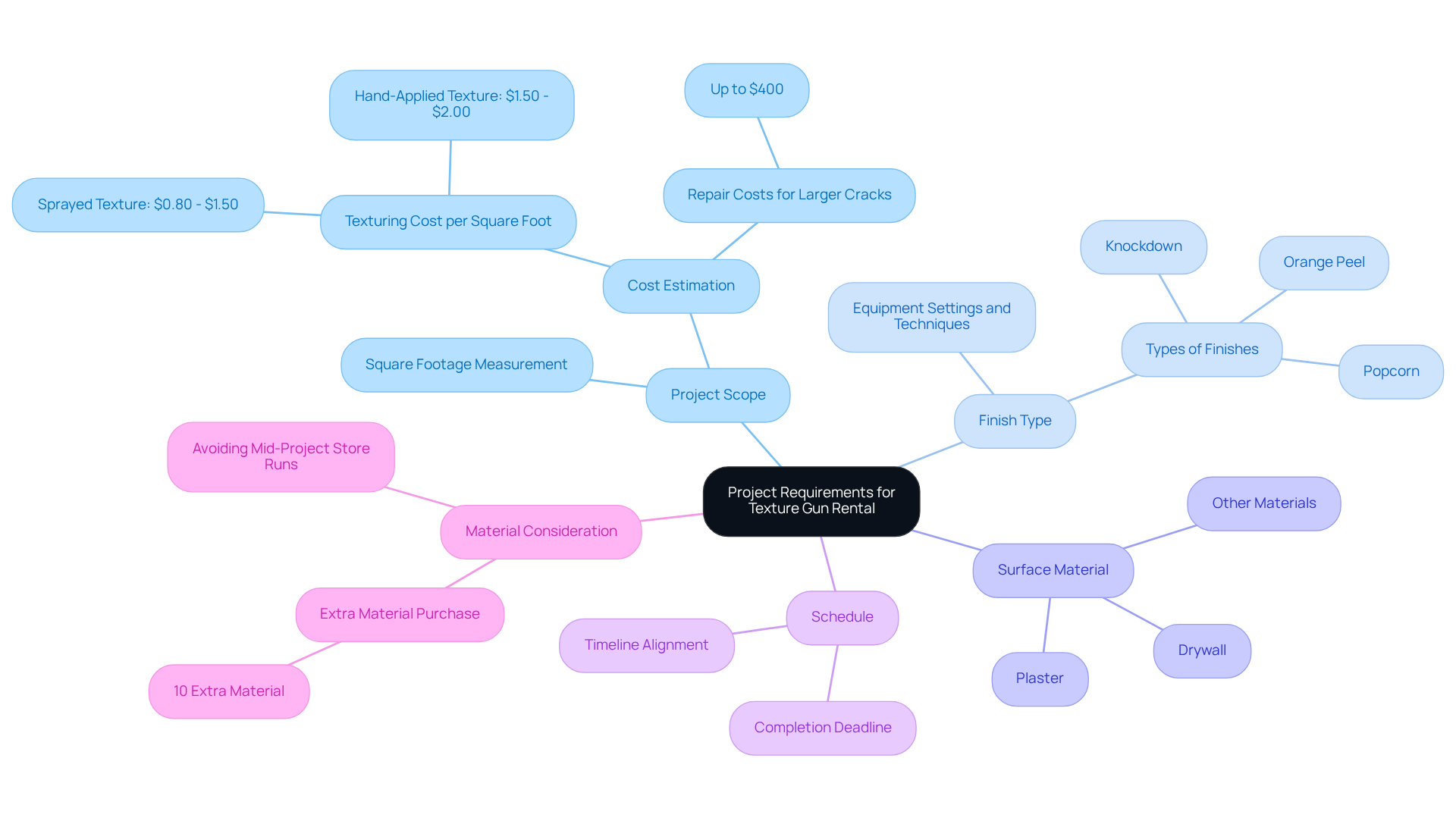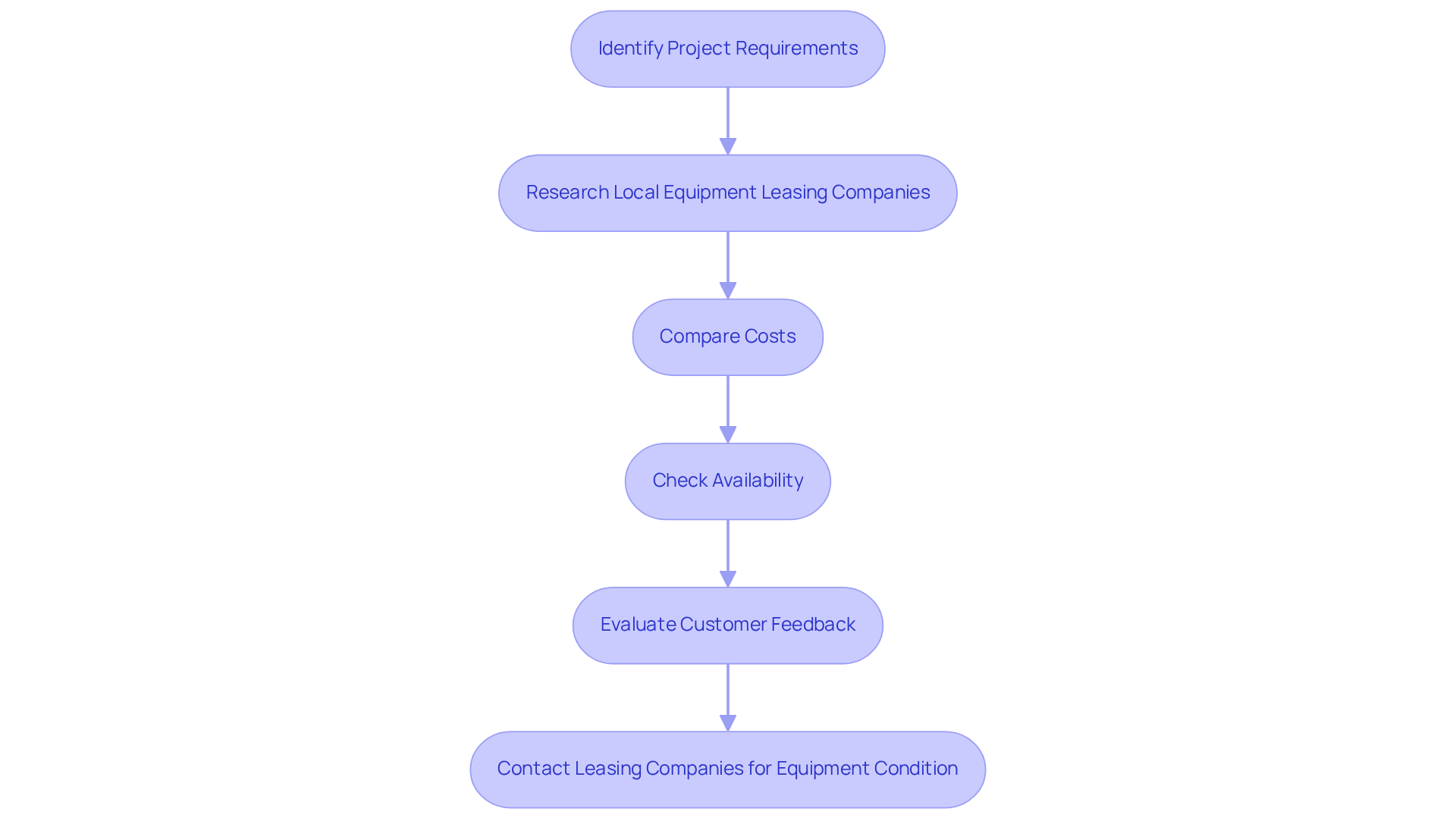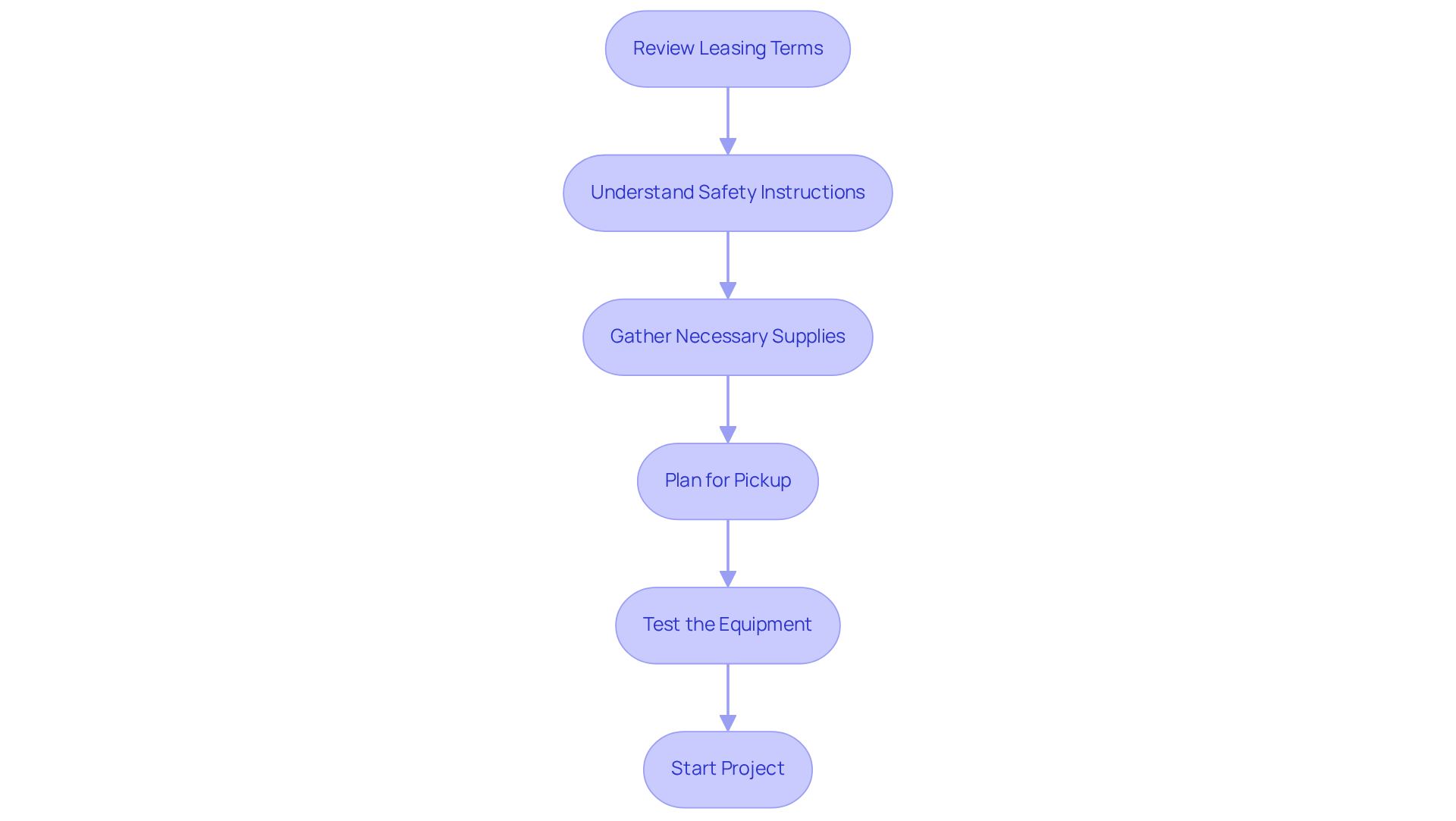Overview
The primary objective of this article is to equip managers with a thorough guide on effectively renting a texture gun for construction projects. It delineates essential steps, including:
- Evaluating project requirements
- Researching rental services
- Communicating specific needs
- Finalizing agreements
- Preparing for the use of equipment
This guide underscores the critical role of meticulous preparation and clear communication in ensuring a successful rental experience.
Key Highlights:
- Evaluate project requirements including scope, finish type, surface material, schedule, and material considerations for effective texture gun rental.
- Research local rental services, compare costs, confirm availability, and assess customer feedback to select a reliable provider.
- Communicate your needs clearly with the leasing service, negotiate terms, and review the rental agreement to avoid misunderstandings.
- Understand leasing terms, familiarise yourself with safety instructions, gather necessary supplies, and plan for pickup to ensure smooth equipment use.
- Test the texture gun before starting the project to ensure it operates correctly and to familiarise yourself with its controls.
Introduction
Navigating the complexities of a construction project often hinges on the effective use of specialized equipment, and texture guns are no exception. For managers tasked with overseeing such endeavors, understanding how to efficiently rent a texture gun can significantly enhance workflow and project outcomes.
With a myriad of rental services available and various factors to consider—from project specifications to rental agreements—ensuring a seamless experience becomes paramount. This guide delves into the essential steps for mastering texture gun rental, equipping managers with the knowledge to tackle challenges head-on and optimize their project execution.
Identify Your Project Requirements for Texture Gun Rental
To effectively oversee your gun rental, begin by evaluating your undertaking's specific requirements. Consider the following key factors:
- Project Scope: Accurately determine the square footage of the area requiring texturing. This measurement is crucial for estimating the amount of material needed, as the average cost for texturing drywall ranges from $1.25 to $1.52 per square foot. Additionally, be aware that larger cracks can cost up to $400 to repair, emphasizing the importance of thorough project assessment.
- Finish Type: Identify the desired surface finish, such as knockdown, orange peel, or popcorn. Each type may require different equipment settings and techniques, impacting your selection of spray gun.
- Surface Material: Understand the surface to which the finish will be applied, whether drywall, plaster, or another material. This knowledge is vital, as it can significantly impact the effectiveness of the texture application.
- Schedule: Establish a clear timeline to ensure that your lease period aligns with your work schedule. Understanding your completion deadline will assist you in choosing the suitable duration for the lease, reducing downtime and ensuring efficiency.
- Material Consideration: It’s advisable to purchase about 10% extra material to avoid costly mid-project store runs, which can disrupt your timeline and budget.
By clearly defining these requirements, you can streamline the rental process, ensuring you select the right equipment suited to your needs. This proactive method not only improves efficiency but also aids in the overall success of your construction endeavor. As a HomeAdvisor Staff Writer notes, overseeing a construction endeavor comes with many challenges, from selecting the right equipment to staying within budget.

Research and Compare Texture Gun Rental Services
Once you have identified your project requirements, conducting thorough research on leasing services is essential. Start by exploring local equipment leasing companies, such as EZ Equipment Lease, which is recognized for its extensive selection of tools and equipment tailored to various needs.
Next, compare costs by examining leasing rates for spray guns from various suppliers. Pay attention to both daily and weekly charges to identify the most economical choice, as the average leasing rates in the Dallas-Fort Worth area can vary significantly.
Confirm the availability of the texture gun rental you need for your desired usage period. Availability can fluctuate, particularly during peak seasons, so early inquiries are advisable to ensure you secure the equipment you require.
Investigate customer feedback and ratings to evaluate the reliability and quality of the leasing service. Positive feedback frequently indicates a reliable provider, which is essential for ensuring success in your endeavor.
Finally, contact leasing companies to inquire about the maintenance and condition of their equipment. Well-kept tools not only operate more effectively but also reduce the risk of complications during your task.
By diligently researching and comparing leasing services for texture gun rental, you can choose a provider that aligns with your requirements and budget, ensuring a smooth and efficient workflow.

Communicate Your Needs and Finalize the Rental Agreement
After selecting a leasing service, it is essential to effectively communicate your requirements and finalize the leasing agreement. To ensure a seamless process, follow these steps:
- Engage with the Leasing Service: Initiate contact with the chosen leasing company to discuss your project needs and confirm the availability of the spray gun. Establishing a connection with the leasing service can significantly enhance negotiations.
- Clarify your requirements for the texture gun rental by specifying the type of texture gun you need, the duration of use, and any additional accessories required (e.g., hoppers, compressors). Providing clarity in your specifications helps prevent misunderstandings.
- Negotiate Terms: Engage in discussions regarding leasing rates, deposit requirements, and any potential discounts for extended lease periods. Do not hesitate to negotiate for terms that align with your budget. Remember, effective communication can lead to a more favorable outcome.
- Examine the Contract: Thoroughly review the lease agreement, ensuring all terms are clear, including duration, costs, and responsibilities for damages. A meticulous review helps avoid disputes in the future.
- Seek Clarification: If any aspect remains unclear, do not hesitate to ask the service for clarification. Understanding the terms will help avoid misunderstandings and ensure a smooth leasing experience. Confirming delivery times and other logistical details is also crucial for effective communication.
By clearly conveying your needs and finalizing the lease agreement, you can enhance customer satisfaction and secure a successful leasing experience.

Review Rental Terms and Prepare for Equipment Use
Before picking up the texture gun rental, it is essential to thoroughly review the rental terms and prepare for its use.
-
Understand Leasing Terms: Carefully examine the leasing agreement to grasp your responsibilities, including maintenance, cleaning, and return conditions. This ensures compliance and avoids potential penalties, setting the stage for a smooth texture gun rental.
-
Safety Instructions: Familiarize yourself with the safety instructions provided by the rental company. Understanding how to use the spray gun safely is crucial, as improper operation can lead to accidents. Industry reports indicate that incorrect handling of equipment contributes significantly to safety incidents in construction settings, underscoring the need for diligence in following safety protocols.
-
Gather Necessary Supplies: Prepare all required materials for your project, including substance compounds and protective gear such as gloves, goggles, and masks. Utilizing appropriate personal protective equipment (PPE) minimizes risks when using the application gun and ensures a safer working environment.
-
Plan for Pickup: Arrange a suitable time to collect the texture gun rental, ensuring you have appropriate transportation to carry it safely. This proactive approach helps prevent damage during transit and ensures you arrive at your job site ready to work efficiently.
-
Test the Equipment: If possible, test the texture gun before beginning your task. This allows you to confirm that it operates correctly and helps you become familiar with its controls, enhancing your efficiency and safety during use.
By reviewing rental terms and preparing adequately, you position yourself for a successful project with minimal disruptions, ensuring both safety and productivity.

Conclusion
Mastering the process of texture gun rental is crucial for ensuring the success of any construction project. Effectively identifying project requirements, researching rental services, and communicating needs allows managers to streamline the rental experience and enhance overall project efficiency. This guide emphasizes the importance of preparation and informed decision-making, ultimately leading to a smoother workflow and successful outcomes.
Key insights from this article highlight the necessity of understanding project specifications, comparing rental options, and finalizing agreements with clarity. Managers are encouraged to assess project scopes, desired finishes, and material types to select the most suitable equipment. Furthermore, thorough research on rental services, along with effective communication, can significantly impact the quality of the rental experience.
In summary, the process of renting a texture gun involves careful planning and execution from start to finish. By following the outlined steps and best practices, managers can not only meet their project goals but also foster a safer and more productive working environment. Embracing these strategies will ensure that texture gun rental becomes a seamless part of the construction process, setting the stage for successful project completion.
Frequently Asked Questions
What should I evaluate before renting a texture gun?
Before renting a texture gun, evaluate your project's specific requirements, including project scope, finish type, surface material, schedule, and material considerations.
How do I determine the project scope for texturing?
Accurately measure the square footage of the area that requires texturing. This measurement is crucial for estimating the amount of material needed.
What is the average cost for texturing drywall?
The average cost for texturing drywall ranges from $1.25 to $1.52 per square foot.
Why is it important to consider repair costs for larger cracks?
Larger cracks can cost up to $400 to repair, so assessing the project thoroughly can help avoid unexpected expenses.
What types of surface finishes should I consider?
Consider the desired surface finish, such as knockdown, orange peel, or popcorn, as each may require different equipment settings and techniques.
How does the surface material affect my texture application?
Understanding whether the surface is drywall, plaster, or another material is vital, as it can significantly impact the effectiveness of the texture application.
Why is it important to establish a project schedule?
Establishing a clear timeline helps ensure that your lease period aligns with your work schedule, reducing downtime and improving efficiency.
How much extra material should I purchase for my project?
It’s advisable to purchase about 10% extra material to avoid costly mid-project store runs that can disrupt your timeline and budget.
How can clearly defining project requirements help with the rental process?
Clearly defining your project requirements can streamline the rental process, ensuring you select the right equipment suited to your needs and improving overall project success.




